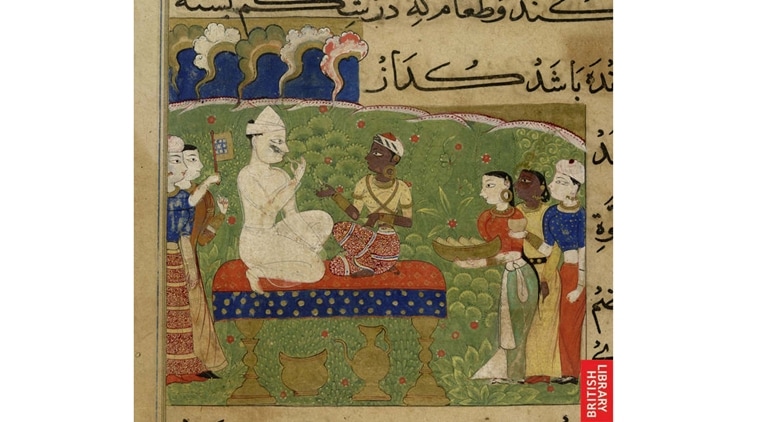📣 For more lifestyle news, click here to join our WhatsApp Channel and also follow us on Instagram
The culinary adventures of Ghiyath Shah, the sultan of Malwa
The ultimate bon vivant, Ghiyath Shah’s 600-year-old Nimatnama, a "book of pleasures", introduced cookbooks to miniature painting.
 The Nimatnama (Book of Pleasures) is currently at the India Office Library, in London, and it reportedly begins with a plea to the King of Cockroaches. (Source: Wikimedia Commons)
The Nimatnama (Book of Pleasures) is currently at the India Office Library, in London, and it reportedly begins with a plea to the King of Cockroaches. (Source: Wikimedia Commons)
Ghiyath Shah became the sultan of Malwa (present day Madhya Pradesh) in 1469. He died in 1500. In the intervening 30-odd years, Shah, after handing over the reins of his kingdom to his son Nasir, devoted his life to experiencing the pleasures of, well, life. This 15th century Hugh Hefner of sorts had, it is said, a harem studded with 15,000 women, and he also built several of Mandu’s pleasure palaces (Mandu was then the capital of Malwa). Apparently, in his later days, when he was no longer the spry goat he had once been, Shah needed the help of his concubines to climb the steep winding staircases in his various abodes. On each step, bare-chested maidens were said to thrust their breasts forward for the old king to hold for support.
Shah was also deeply interested in food. In fact, he was such a huge foodie that he married the miniature style of painting with food, and left behind for us the Nimatnama, a book that is mostly devoted to Shah’s favourite dishes.
The Nimatnama (Book of Pleasures) is currently at the India Office Library, in London, and it begins, according to Aashpaz.com, with this plea: “King of cockroaches! Please do not eat this, my offering to the culinary world — recipes of cooking food, sweetmeats, fish and the manufacture of rose-water perfumes.”
 Ghiyath Shahi seated on a stool in a garden is being offered a dish, possibly of samosas. (Source: Wikimedia Commons)
Ghiyath Shahi seated on a stool in a garden is being offered a dish, possibly of samosas. (Source: Wikimedia Commons)
The script in the Nimatnama is Naskh, a calligraphic style of writing in the Arabic alphabet, says Hyderabad-based art dealer and food aficionado Syed Mohammad Husayn. “I’m into paan, and Nimatnama has comprehensive information on the various varieties of betel leaves. And kheema, there are detailed descriptions on how to prepare it.” The book, says Husayn, is among the first detailed and illustrated one of its kind from the medieval period. “It has 50 wonderful miniatures made in the Persian-Turk style. Each miniature has Ghiyath Shah at the centre — he liked to be in the thick of things — followed by a detailed explanation of cooking techniques.”
 The Nimatnama contains, among others, recipes for Flavoured Mutton, Samosas, Vadas and many other dishes. (Source: Westindischer Maler um 1510/Wikimedia Commons)
The Nimatnama contains, among others, recipes for Flavoured Mutton, Samosas, Vadas and many other dishes. (Source: Westindischer Maler um 1510/Wikimedia Commons)
Apart from detailed information on the preparation of aphrodisiacs — he would have needed lots — the Nimatnama contains, among others, recipes for Flavoured Mutton, Samosas, Vadas and many other dishes, and resounds with echoes of the food we eat today: paluda, burani, shorba, sambusa…
 Enjoyment of betel. Ghiyath Shahi is kneeling on a stool, putting a betel chew in his mouth. (Source: Wikimedia Commons)
Enjoyment of betel. Ghiyath Shahi is kneeling on a stool, putting a betel chew in his mouth. (Source: Wikimedia Commons)
Here is how, Shah says, one should cook Saffron Meat: Wash the meat well and, having put sweet-smelling ghee into a cooking pot, put the meat into it. When the ghee is hot, flavour it with saffron, rosewater and camphor. Mix the meat with the saffron to flavour it and when it has become well-marinated, add a quantity of water. Chop cardamoms, cloves, coriander, fennel, cinnamon, cassia, cumin and fenugreek, tie them up in muslin and put them with the meat. Cook almonds, pine kernels, pistachios, and raisins in tamarind syrup and add them to the meat. Put in rosewater, camphor, musk and ambergris and serve it. By the same method cook partridge, quail, chicken and pigeon.
For those interested, the a version of the book is available here.
For news updates, follow us on Facebook, Twitter, Google+ & Instagram
📣 For more lifestyle news, click here to join our WhatsApp Channel and also follow us on Instagram
- 01
- 02
- 03
- 04
- 05



























